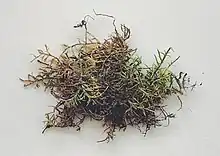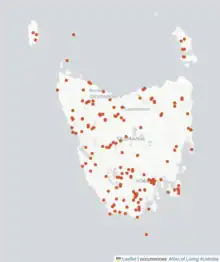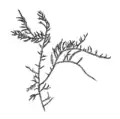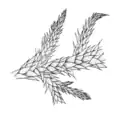| Wijkia extenuata | |
|---|---|
 | |
| Scientific classification | |
| Kingdom: | Plantae |
| Division: | Bryophyta |
| Class: | Bryopsida |
| Subclass: | Bryidae |
| Order: | Hypnales |
| Family: | Pylaisiadelphaceae |
| Genus: | Wijkia |
| Species: | W. extenuata |
| Binomial name | |
| Wijkia extenuata (Brid.) H.A.Crum | |
| Varieties | |
| |
 | |
| Distribution of Wijkia extenuata in Tasmania, Australia from the Atlas of Living Australia. | |
| Synonyms | |
|
Hypnum extenuatum Brid. | |
Wijkia extenuata, commonly known as spear moss or spiky wiki, is a species of moss from the family Pylaisiadelphaceae.[1][2][3] It can be divided into two varieties Wijkia extenuata '-var. caudata and Wijkia extenuata var. extenuata. It is commonly found throughout the tropical, subtropical, and temperate forests of eastern Australasia and New Zealand.
Taxonomy
Wijkia is a tropical to subtropical genus consisting of about 25-30 Old and New World species.[4] This species' previous name Acanthocladium extenatum was replaced by Crum (1971)[5] and is represented by a single species in Tasmania.[6] and New Zealand[7] The genus was previously placed in family Sematophyllaceae, but moved to the newly described Pylaisiadelphaceae when Sematophyllaceae was split on the basis of molecular DNA data.[2][8][3] The genus was named in honour of Sir Roelof J. van der Wijk (1895-1981), a Dutch bryologist.[9]
Description
Wijkia extenuata is a variable species of small to medium-sized plant where the appearance of both varieties shares many of the same features. Both varieties are stiff, compactly branched plants with lose forming tufts to soft, pendulous forms. Plants are of yellow to brown-green or dark green colouration and turns golden with age with loosely interwoven mats. Stems are red, irregularly creep and are bipinnately or subpinnately branched about 12 cm (4.7 in) long. Branches pinnately or with simple branch, ascendant or creeping, and branchlets near tips are often with multiple flagelliform and microphyllous. The only very common distinction between variants is the presence of predominant branches. The “branch-only” growth does not develop flagelliform branches and are distinctive to the variation caudata.[10]
Leaves in stem and branch are differentiated, and ecostate. Stem leaves are broadly ovate to lanceolate, appressed to erect and wide-spreading when dry, abruptly tapered to a slender with occasional serrulate, piliferous apex; about ~1-2mm long in primary leaves and around 1.5 mm (0.059 in) long in secondary leaves. Branch leaves lanceolate to ovate-lanceolate, smaller about 0.5–1 mm (0.020–0.039 in) long, sharply toothed, slenderer, erect to erect spreading, concave with gradually short acuminate to apex; occasional strong serrulate margins to the base and not piliferous. It is seemingly similar to the species Calliergonella cuspidata but differs with the distinctive long hairpoint on the leaves.[6] The plant reproduces asexually through specialised flagelliform and deciduous branchlets with foliose, deltoid pseudoparaphyllia.
Its perichaetia are conspicuous, scattered and arising on stems; inner perichaetial leaves erect with long and sharp toothed acumen. Setae are red-brown, smooth, elongate, twisted to the left above, and 15–40 mm (0.59–1.57 in) long. Calyptra are smooth, and cucullate. Capsules about 1.5 mm (0.059 in) long, asymmetric, horizontal, oblong-cylindric below the mouth, and short neck. Annulus are differentiated, operculum base high-conic, blunt, arched, and lacks long rostrum. Peristomes are pale, double; strongly bordered and shouldered 16 exostome teeth with a zig-zag median line, trabeculae on inner surface; endostome 16 with perforated or keeled segments, high basal membrane, and cilia in single or pairs. Spores are about 12–16 µm in diam., papillose, and spherical.
Habitat and distribution
Both varieties of Wijkia extenuata are commonly found growing on logs or decaying wood, bases of trees, as an epiphyte, and rarely on rocks and soils.[11] Both are a common species in wet forests and rainforests from east Australia (QLD, NSW, ACT, VIC, and TAS), Papua New Guinea, New Zealand, and Pacific Island nations such as Fiji.
Gallery
 Wijkia extenuata caudata
Wijkia extenuata caudata Wijkia extenuata extenuata
Wijkia extenuata extenuata A variable Wijkia extenuata found near Growling Swallet, Tasmania
A variable Wijkia extenuata found near Growling Swallet, Tasmania
References
- ↑ Goffinet, B.; Buck, W.R. (4 March 2014). "Classification of extant moss genera". Classification of the Bryophyta. Retrieved 1 May 2020.
- 1 2 Goffinet, B.; Buck, W. R.; Shaw, A. J. (2008). "Morphology and Classification of the Bryophyta". In Goffinet, B.; Shaw, J. (eds.). Bryophyte Biology (2nd ed.). New York: Cambridge University Press. pp. 55–138. ISBN 978-0-521-87225-6.
- 1 2 Ramsay, Helen P. (2012). "PYLAISIADELPHACEAEE" (PDF). Australian Mosses Online. Retrieved 22 March 2023.
- ↑ Buck, William Russel (1986). "Wijkia in the New World". Hikobia. 9: 297–303.
- ↑ Crum, Howard (1971). "Nomenclatural Changes in the Musci". The Bryologist. 74 (2): 165–174. doi:10.2307/3241832. ISSN 0007-2745. JSTOR 3241832.
- 1 2 "Key to Tasmanian Dicots". www.utas.edu.au. Retrieved 2023-03-22.
- ↑ Ramsay, H. P.; Schofield, W. B.; Tan, B. C. (2002). "The family Sematophyllaceae (Bryopsida) in Australia. Part 1: Introduction, family data, key to genera and the genera Wijkia, Acanthorrynchium, Trismegistia and Sematophyllum". Journal of the Hattori Botanical Laboratory. 92: 1–50. ISSN 0073-0912.
- ↑ Ramsay, Helen P. (2012). "SEMATOPHYLLACEAE" (PDF). Australian Mosses Online. Retrieved 22 March 2023.
- ↑ Ramsay, Helen P. (2012). "Wijkia H.A.Crum" (PDF). Australian Mosses Online. Retrieved 22 March 2023.
- ↑ "Wijkia H.A.Crum". www.nzflora.info. Retrieved 2023-03-22.
- ↑ Fife, Aj (2012-12-01). "New taxa of Sematophyllum and Wijkia (Musci: Sematophyllaceae), with a key to New Zealand Sematophyllaceae". New Zealand Journal of Botany. 50 (4): 435–447. doi:10.1080/0028825X.2012.728993. ISSN 0028-825X. S2CID 84950979.